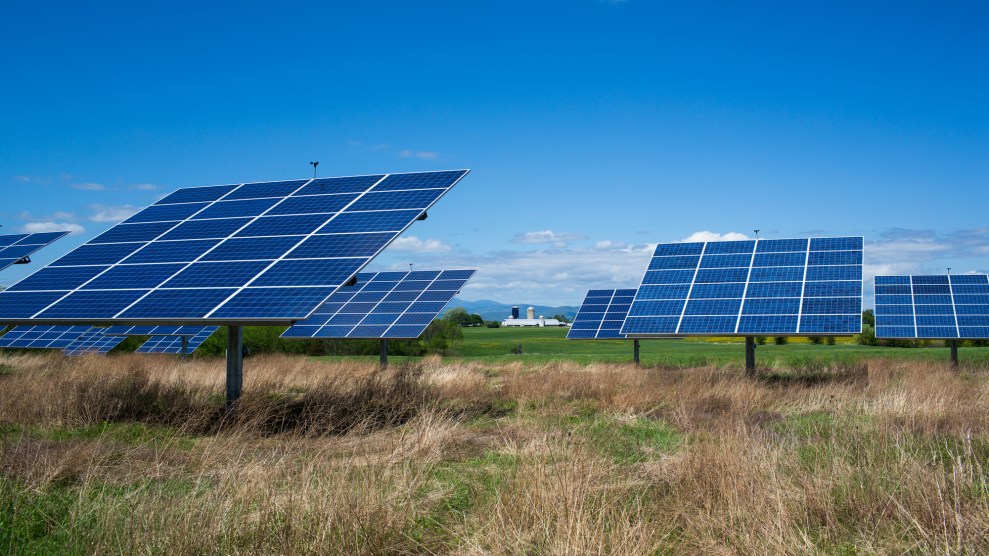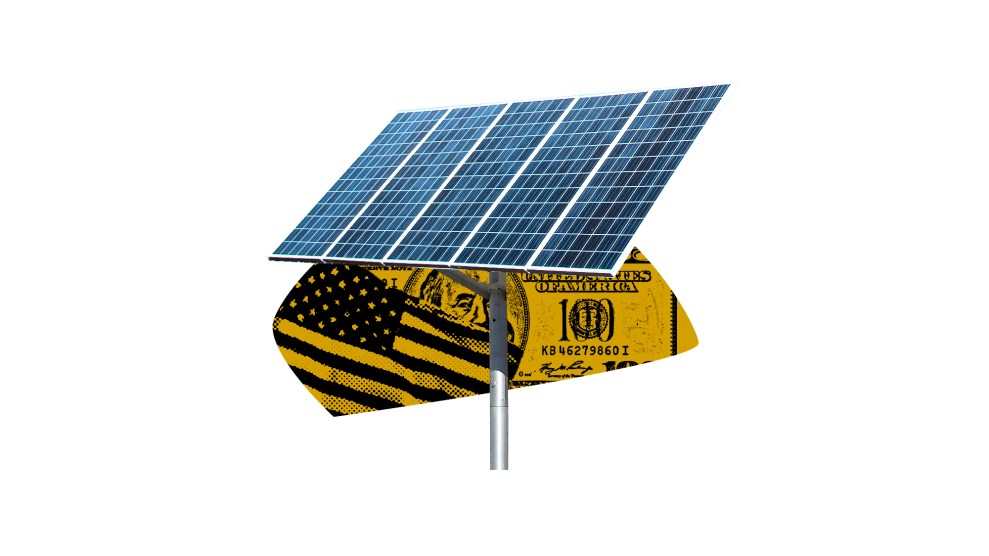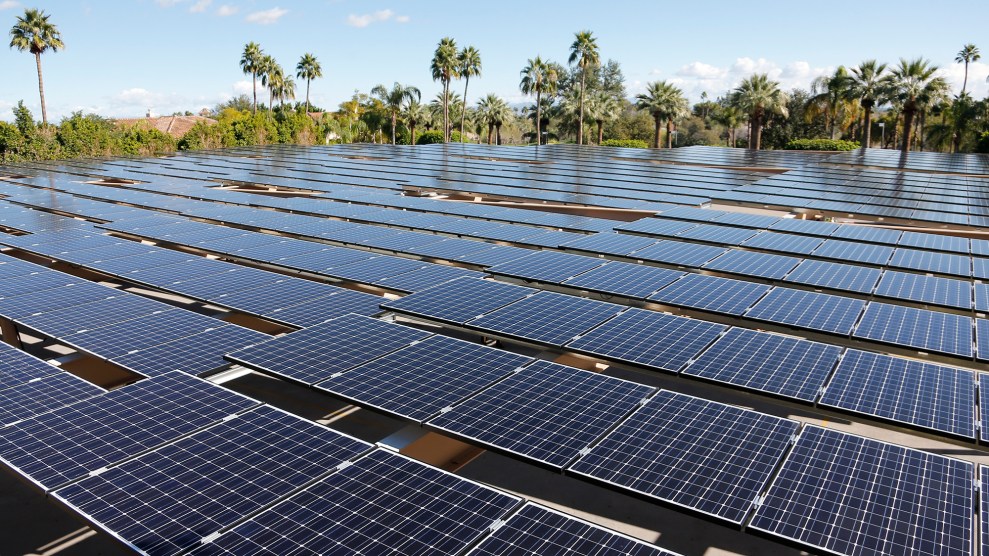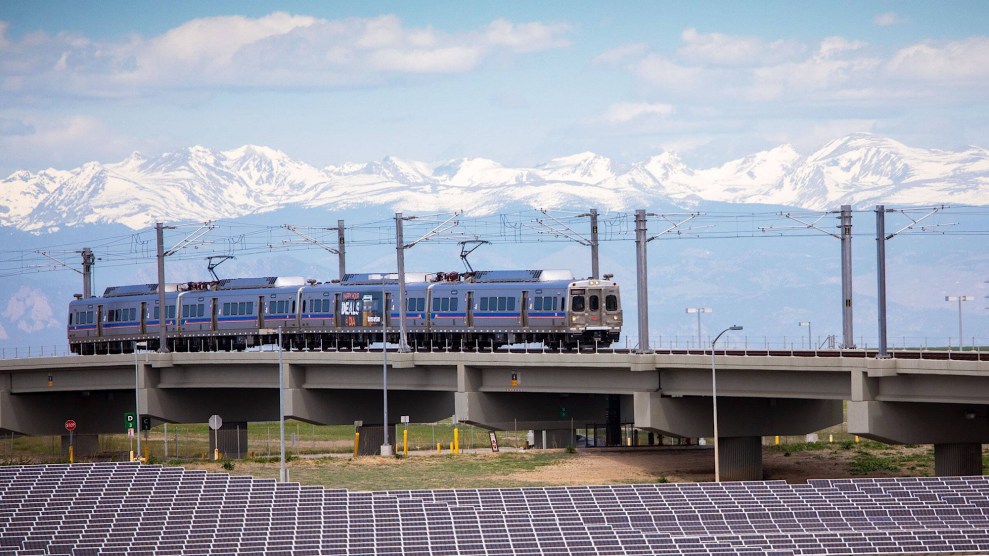
A solar array on a dairy farm near West Haven, Vermont. Robert Nickelsberg/Getty
This story was originally published by Inside Climate News and is reproduced here as part of the Climate Desk collaboration.
A new study finds that houses within a half-mile of a utility-scale solar farm have resale prices that are, on average, 1.5 percent less than houses that are just a little farther away.
The research from Lawrence Berkeley National Laboratory (LBNL) helps to refute some of the assertions of solar opponents who stoke resistance to projects with talk of huge drops in property values. But it also drives a hole through the argument made by people in the solar industry who say there is no clear connection between solar and a drop in values.
The authors analyzed 1.8 million home sales near solar farms in six states and found diminished property values in Minnesota (4 percent), North Carolina (5.8 percent) and New Jersey (5.6 percent). The three other states—California, Connecticut and Massachusetts—had price changes that were within their margins of error, which means the price effects were too close to zero to be meaningful. The paper was published in the journal Energy Policy.
The authors accounted for differences in property features, inflation, and other factors in order to isolate the effect of proximity to solar.
Ben Hoen, a co-author and research scientist at LBNL, said the numbers are clear but additional research is needed to understand what’s happening on the local level to lead to these price effects. “We have a sense of the ‘what,’ but we don’t know the ‘why,’” he said. For example, he doesn’t have a thorough explanation for why the price differences are higher in some states than others.
The researchers chose this group of states because they were, except for Connecticut, the top five in the country for the number of solar installations of at least 1 megawatt as of 2019. They included Connecticut because it is an example of a state with a high population density near solar projects.
Hoen emphasized that the results show a period in time, with transactions that occurred from 2003 to 2020, and may not reflect prices right now. Also, he noted that the paper’s analysis doesn’t take into account any of the financial benefits of solar for landowners and communities, which may include payments from the developer and a decrease in local taxes.
The study is being released at a time of rapid expansion in the number and size of solar projects, which is a key part of the country’s push to reduce the emissions that contribute to climate change.
The scale of growth in solar development has been met with an intensifying resistance in local communities where some people argue that the projects are ugly and pose a threat to property values and human health. Solar opponents amplify these concerns on social media.
Of all the arguments against solar, the idea that it will hurt property values has been among the most potent, based on prior reporting by Inside Climate News about the local debates. At public hearings and in comments filed with regulators, some residents talk about how they fear reductions of 40 percent or more. Asked if he saw anything in his data to support these claims, Hoen said there is “no evidence that an effect that large exists.”
Jeffrey Jacquet, an Ohio State University professor who has written about conflicts over renewable energy projects, said the new paper is impressive in its depth and shows the need to ask more questions about the benefits and drawbacks of development for host communities. “I think the takeaway is that the effect of renewables on property values is small on average, but it is not zero, and we need to correct for that negative impact,” he said.
Before this latest study, the largest one done in the United States was in 2020 by researchers at the University of Rhode Island who looked at about 400,000 real-estate transactions in Rhode Island and Massachusetts. They found that the value of houses within one mile of a solar project decreased by an average of 1.7 percent following construction of the project.
The two studies each show a small decrease in values of properties near solar projects, although Hoen cautioned against comparisons because the two are different in their geographic scope and the number of transactions reviewed.
Clean energy advocates and the solar industry may be pleased that the study finds no large negative effect on property values, but they also are wary of the core finding that there is a measurable, albeit small, effect.
“There is nothing revelatory in this study—the results are not definitive and only cover a narrow data set,” said Jason Ryan, a spokesman for the American Clean Power Association, a trade group, in a statement. “The report, which found no evidence of adverse impacts on property values in half the states studied, is largely consistent with many prior studies finding that solar projects don’t adversely affect property values. Appraisal data from across the country also show similar conclusions.”
One of the larger points is that a 1.5 percent shift in prices is not enough to be meaningful, said Richard Kirkand, a property appraiser in Raleigh, North Carolina. He has spent about 15 years analyzing property values near solar projects. He often works on behalf of solar companies in regulatory cases before state and local regulatory agencies. “You can’t really measure things that small in real estate from an appraisal standpoint,” he said.
Among the many problems with drawing conclusions from such a small difference is that there are many factors at play, including the desirability of the house and the features of the land, he said. The presence of a solar project is one of those factors, and it’s difficult to say how much weight it has. In his experience, solar projects do not lead to a pattern of a negative effect on the values of nearby properties.
Kirkland is far from alone in coming to this conclusion. In Chisago County, Minnesota, which has more solar projects than any other county in the state, officials have been monitoring real-estate transactions to try to detect any changes in resale prices as a result of solar development. They haven’t found any negative effects, either in 2017 after the construction of the state’s largest solar array, or as recently as December, according to the county assessor’s office.
Hoen said that a 1.5 percent difference may not be significant for an appraiser looking at a small number of transactions, but it is significant in a statistical analysis like the one in the paper. And, even if there are many factors at play, he is confident that proximity to solar is a strong factor explaining the price difference.
He is eager to ask follow-up questions in additional studies to get an idea of what solar-related factors are contributing to negative effects of pricing. For example, he wonders if an increase in local controversy surrounding a project leads to larger decreases in property values. “Unpacking these types of mechanisms will take further study,” he said.











